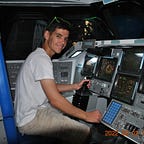Day 8: The Lost Engineering Marvel of Rocketdyne’s F-1 Engines
As we advance our technology ever forward, you would think that remaking a 50-year old design should be easy; however, things are not quite as simple as they first seem.
The most powerful single-chamber liquid-propelled rocket engine ever built to date, the mighty Rocketdyne F-1 was a masterful piece of engineering which some deem to be the most important part of what got men to the moon. Despite being extremely powerful, what made the F-1 especially unique was how simple they were. This meant they were cheap enough to be mass-produced and disposable, making production of the Saturn V fast and cheap as well. Compare this to the RS-25 engines (flown on the Shuttle and to be flown on SLS), whose complex design puts their price tag at around $1.15 million per piece. Unlike the F-1s, these engines could not be as readily produced; while the Shuttle preserved it’s engines when it came back to Earth, SLS would be disposing them, making it much more expensive than the Saturn V. So, if we have an engine that is already capable of taking us to the moon, why don't we just remake them?
A very popular myth went around NASA saying that engineers had simply ‘thrown away’ the blueprints for the F-1s. Of course, this would never be done: every design document ever created for the Apollo program is still available in NASA archives (both physical in the Library of Congress and in both Space Centers, and digital in NASA.gov/archives).
The problem in recreating the F-1 engines revolves around the fact that engineers in the 1960s who designed and built the F-1s possessed a subset of skills which little to no people possess today. In the 60s, components were designed, built, tested and then often modified before being used. Complex sub-assemblies — or components built in separate areas designed to be fitted together at the end of the build process — were welded together from sometimes hundreds of smaller parts, taking exceptionally skilled welders (some of whom originated from WWII production lines, another factor that we do not have in the modern day) sometimes a full day to complete weld projects.
The original builders of the F-1 engines were highly skilled engineers, welders and fitters that did almost everything by hand, save the use of lathes and some machinery. In the rush to meet deadlines, they kept many of the tricks that they used to get things to work and go together in their heads or scribbled down on scraps of paper long since lost to time. 50 years later, and all of those skilled people have long since retired or passed away, taking their skills and knowledge with them to their graves.
When a group of present-day rocket engineers looked at how they could recreate the iconic F-1 engines, they were faced with the reality of how complex the engineering that went into the F-1s was. Although they had the original blueprints for the engines, what they found is that they were missing the notes made by the engineers as they effectively handcrafted every engine, each one slightly different with its own quirks and unique flaws/attributes.
With the advent of modern manufacturing techniques, those skills are no longer in use, and few people today had the need let alone the motivation to learn them. Faced with 50-year old blueprints, we find we just don't have the skills to make them the way they did. In essence, these engines have become unattainable relics of the past. By detailed examination of the remaining F-1 engines from museums and storage, the modern engineers discovered enough to create a new F-1B engine concept.
Using modern computer modeling and manufacturing techniques, the F-1B could not only be efficient, but would also be just as powerful as its predecessor concept F-1A — which was a design concept proposed in 1968 as an improved F-1 variant for future Saturn V launches — at 1.8 million pounds of thrust.
Although in the end NASA never selected the F-1B for its SLS, opting for the extensively tested solid rocket boosters for the SLS, this project demonstrated that it is sometimes simpler to start from scratch when designing something as complex as a rocket engine than it is to attempt to reproduce a relic of the past.
